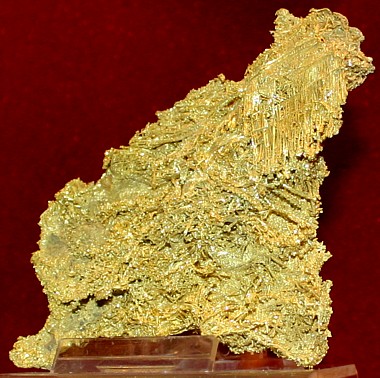
| GOLD MINERAL FACTS |  |
|
| The Gem and Mineral Collector's Photo Gallery by Nevada Outback |
|
. Gold Mineral Facts: Chemical Formula: Au Colors: The mineral is various shades of metallic yellow, depending upon purity, becoming paler with increase in the percentage of silver present.
Hardness:
2.5 to 3 Cleavage: None
Crystallography: Isometric Luster:. Metallic, with a yellow streak. Optics: (Refractive Index): Opaque |
Octahedral Gold crystals attached together, specimen from California |
. |
Identification and Diagnostics
Occurrence,
Localities and Origins: Important gold-producing countries include: South Africa, Australia, the USA, Russia, Mexico and Canada, and ore recently, China. Gold has been obtained in large quantity along the eastern flanks of the Ural Mountains, this having been the most productive region in the world between the years 1819 and 1849. In Russia gold has been mined in western Siberia and the Urals, in the Irkutsk Province, in Transbaikalia and Amur. Important production has also come from the mountains of southeastern Brazil, and from the highlands of many of the Central and South American countries. The western portion of the United States, more particularly from the western slopes of the Sierra Nevada Mountains, the state of Nevada and the higher portions of the Rocky Mountains. Gold bearing quartz veins have been worked at various points in Alaska, at Porcupine, Ontario, and other points in Canada. The region of South Africa known as the Rand, near Johannesburg in the Transvaal, has historically been the most productive gold district in the world. The gold occurs here scattered throughout inclined beds or "reefs" of a quartzose conglomerate, which has been mined to great depths. Australia has the following chief gold districts: Kalgoorlie in western Australia (largely tellurides), Ballarat and Bendigo in Victoria, Mount Morgan in Queensland and various fields in New South Wales. The production of Mexico comes chiefly from the districts of Guanajuato, El Oro and Dolores. The bulk of the production from Nevada comes from sedimentary hosted "Carlin Type deposits". The great placer mines of the world are in California, Australia and Alaska. In Australia the principal gold mines are situated in the streams rising in the mountains of New South Wales and their extension into Victoria. A century ago, the valleys of the Yukon and other rivers in Alaska attracted much attention, as did the beach sands off Nome, which have yielded much of the metal. Return to the Mineral Collectors Information Page |
To view additional Gold Photos see:
Gold Nugget Photos
|
|
|
|
||
 |
||
|
|
|
|
Please note that the author, Chris Ralph, retains all copyrights to this entire document and it may not be reproduced, quoted or copied without permission.

NEVADA OUTBACK GEMS TURQUOISE AND JEWELRY